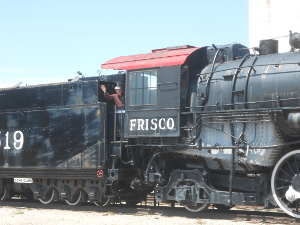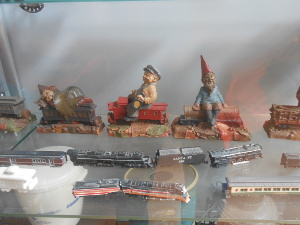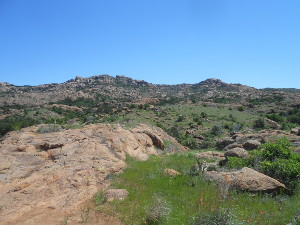 Bumper crop of wheat
Bumper crop of wheat Bumper crop of wheat
Bumper crop of wheat
Elsa's Kansas family lived near the Flint Hills region of Kansas. When we first visited the area, just beginning to study genealogy, we were surprised by the stark beauty of the land, with its open, almost treeless rolling hills. One of the first things we noticed back then was that ranchers used stone slabs as fence posts because there were no tree limbs handy. It was a kind of inspired make-do technology.
This year we came through the Flint Hills and the prairies and farmland beyond, and we were struck by the beauty of this land. We saw it just after a number of rainstorms had moved through, so the creeks were high and the trees were leafing out and all the green plants, from grass to leaves, were shiny and bright. There were some canola  Traveler as engineer
fields just beginning to burst into bright yellow, and the winter wheat is nearly ready for harvest.
Traveler as engineer
fields just beginning to burst into bright yellow, and the winter wheat is nearly ready for harvest.
The Flint Hills are a small part of the Great Plains unsuitable for agriculture, because the flint rocks are right on the surface, leaving no topsoil. But they are wonderful as prairie land for cattle ranchers.
Even though ranching and agriculture are thriving throughout the great plains, the life is often frustrating, subject to the vagaries of weather and management of crops and herds, while the best and brightest of the younger generation go to the cities to attend universities and often do not return to the land.
 Enid model railway layout
Enid model railway layout
In Enid, Oklahoma, they have a bumper crop of winter wheat, which would ordinarily be a good thing, except that right now the elevators are chock full of last Fall's wheat crop which was also much bigger than usual. There is still so much wheat that great piles of it are stacked on the land next to the grain elevators. Covered with giant silver tarps and stirred by a number of fans which run day and night, they are more than ready to be trucked to market. And this year's crop will be kept uncut in the fields as long as possible.
In Enid we visited the railroad museum, the lifetime project of a former railroad engineer, nicknamed  Carved dwarves ride rails
Watermelon, who worked for the railroad for forty-odd years, and started collecting railroad memorabilia right from the get-go. He had china, matchbooks, tools, uniforms, tickets, conductor punches, semaphores, cabooses, locomotives, work cars, linen, ash trays, and six or seven different model train layouts. He was out of town on the day we visited, on a vacation to Texas with his new, fifth wife; he is in his nineties now but still eager to take train trips across the plains land. A woman who has volunteered at the museum for many years showed us around the place, locking and unlocking doors, and flipping switches to that we could see, for example, the model railroads in operation. The whole visit was fun.
Carved dwarves ride rails
Watermelon, who worked for the railroad for forty-odd years, and started collecting railroad memorabilia right from the get-go. He had china, matchbooks, tools, uniforms, tickets, conductor punches, semaphores, cabooses, locomotives, work cars, linen, ash trays, and six or seven different model train layouts. He was out of town on the day we visited, on a vacation to Texas with his new, fifth wife; he is in his nineties now but still eager to take train trips across the plains land. A woman who has volunteered at the museum for many years showed us around the place, locking and unlocking doors, and flipping switches to that we could see, for example, the model railroads in operation. The whole visit was fun.
In Lawton, Oklahoma, we drove into the geologically old Wichita Mountains to one of the first wildlife refuges  Wichita Mountains
established in this country. It was begun by President McKinley and permanently established by President Theodore Roosevelt, and protects three historically-significant animals: elk, bison, and longhorn cattle, all of which are thriving on the 60,000 or so acres of federal land. Here again, the delight was in the Springtime countryside, where we spotted a baby bison with its mother and also a clutch of baby prairie dogs, each about as big as a golf ball. The prairie dog community guards all of the babies as their own -- it takes, after all, a village.
Wichita Mountains
established in this country. It was begun by President McKinley and permanently established by President Theodore Roosevelt, and protects three historically-significant animals: elk, bison, and longhorn cattle, all of which are thriving on the 60,000 or so acres of federal land. Here again, the delight was in the Springtime countryside, where we spotted a baby bison with its mother and also a clutch of baby prairie dogs, each about as big as a golf ball. The prairie dog community guards all of the babies as their own -- it takes, after all, a village.
We visited two museums in Lawton -- the Museum of the Great Plains, and the Comanche National  Baby prairie dogs
Museum. Both are gorgeous. The Museum of the Great Plains is designed to be an outstanding teaching museum for school groups, with a huge map on the floor showing the land of the great plains from Texas to Canada, a thrilling storm cellar where you hear a tornado pass close by, destroying the house above you, a saddlemaker's workshop, depictions of the buffalo that dominated the Great Plains, and a series of cutouts depicting the many great people who came from this land, from Will Rogers to Maria Tallchief.
Baby prairie dogs
Museum. Both are gorgeous. The Museum of the Great Plains is designed to be an outstanding teaching museum for school groups, with a huge map on the floor showing the land of the great plains from Texas to Canada, a thrilling storm cellar where you hear a tornado pass close by, destroying the house above you, a saddlemaker's workshop, depictions of the buffalo that dominated the Great Plains, and a series of cutouts depicting the many great people who came from this land, from Will Rogers to Maria Tallchief.
The Comanche National Museum is a museum of the Comanche Nation, small, with a lot of gorgeous artwork by the renowned Comanche artist Little Chief. The Comanches are believed to be a spin off from the  Famous people of the plains
Shoshone of Wyoming, as the languages are quite similar. But the Comanches are that nation which changed most from the introduction of the horse and the rifle, becoming the most feared riders (and raiders) of the Great Plains, whose forays extended into Mexico. They wandered all over the land, following the herds of bison, and although the United States Army was frequently defeated, or at least outfoxed, by Comanche warriors, it was the slaughter of the buffalo by greedy civilians who forced the Comanche onto reservations. What else could they do? It was the land.
Famous people of the plains
Shoshone of Wyoming, as the languages are quite similar. But the Comanches are that nation which changed most from the introduction of the horse and the rifle, becoming the most feared riders (and raiders) of the Great Plains, whose forays extended into Mexico. They wandered all over the land, following the herds of bison, and although the United States Army was frequently defeated, or at least outfoxed, by Comanche warriors, it was the slaughter of the buffalo by greedy civilians who forced the Comanche onto reservations. What else could they do? It was the land.
Prairie land is partially defined by the prairie grass which sends its roots down deep into the  Painting by Little Chief
ground. The resulting mass braids the roots together over the years until a thick carpet is created, holding moisture in the ground but also preventing sunlight and plowblades from reaching the soil. There is a trend now, both in the Flint Hills of Kansas and further south on the Wichita Mountains National Wildlife Refuge to burn the prairie land before planting a new crop. Patches are burned, in the early evening, and the smoke can be seen and smelled for great distances. The result is black patches on the ground, followed by new grass which looks light green and which makes the cattle very happy to munch. Historically the great plains were often razed for miles by wildfires.
Painting by Little Chief
ground. The resulting mass braids the roots together over the years until a thick carpet is created, holding moisture in the ground but also preventing sunlight and plowblades from reaching the soil. There is a trend now, both in the Flint Hills of Kansas and further south on the Wichita Mountains National Wildlife Refuge to burn the prairie land before planting a new crop. Patches are burned, in the early evening, and the smoke can be seen and smelled for great distances. The result is black patches on the ground, followed by new grass which looks light green and which makes the cattle very happy to munch. Historically the great plains were often razed for miles by wildfires.
The story of this swatch of country from Emporia to Lawton is all about the land, and we, as travelers, have learned to appreciate the people and the country through their love of the land.